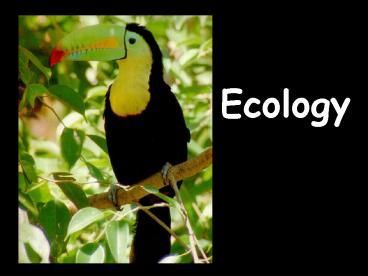Ecology PowerPoint PPT Presentation
1 / 30
Title: Ecology
1
Ecology
2
WHAT IS ECOLOGY?
- Ecology- the scientific study of interactions
between organisms and their environments,
focusing on energy transfer - Ecology is a science of relationships
3
WHAT DO YOU MEAN BY ENVIRONMENT?
- The environment is made up of two factors
- Biotic factors- all living organisms inhabiting
the Earth - Abiotic factors- nonliving parts of the
environment (i.e. temperature, soil, light,
moisture, air currents)
4
Biosphere
Ecosystem
Community
Population
Organism
5
- Organism - any unicellular or multicellular form
exhibiting all of the characteristics of life, an
individual. - The lowest level of organization
6
- POPULATION
- a group of organisms of one species living in
the same place at the same time that interbreed - Produce fertile offspring
- Compete with each other for resources (food,
mates, shelter, etc.)
7
Community - several interacting populations that
inhabit a common environment and are
interdependent.
8
Ecosystem - populations in a community and the
abiotic factors with which they interact (ex.
marine, terrestrial)
9
- Biosphere - life supporting portions of Earth
composed of air, land, fresh water, and salt
water. - The highest level of organization
10
- Habitat vs. Niche
Niche - the role a species plays in a community
its total way of life Habitat- the place in
which an organism lives out its life
11
- Habitat vs. Niche
A niche is determined by the tolerance
limitations of an organism, or a limiting factor.
Limiting factor- any biotic or abiotic factor
that restricts the existence of organisms in a
specific environment.
12
Habitat vs. Niche
- Examples of limiting factors -
- Amount of water
- Amount of food
- Temperature
- Amount of space
- Availability of mates
13
Feeding Relationships
- There are 3 main types of feeding relationships
- 1. Producer - Consumer
- 2. Predator - Prey
- 3. Parasite - Host
14
Feeding Relationships
- Producer- all autotrophs (plants), they trap
energy from the sun - Bottom of the food chain
15
Feeding Relationships
- Consumer- all heterotrophs they ingest food
containing the suns energy - Herbivores
- Carnivores
- Omnivores
- Decomposers
16
Feeding Relationships
- CONSUMERS
- Primary consumers
- Eat plants
- Herbivores
- Secondary, tertiary consumers
- Prey animals
- Carnivores
17
Feeding Relationships
- Consumer-Carnivores-eat meat
- Predators
- Hunt prey
- animals for food.
18
Feeding Relationships
- Consumer- Carnivores- eat meat
- Scavengers
- Feed on carrion,
- dead animals
19
Feeding Relationships
- Consumer- Omnivores -eat both plants
- and animals
20
Feeding Relationships
- Consumer- Decomposers
- Breakdown the complex compounds of dead and
decaying plants and animals into simpler
molecules that can be absorbed
21
Symbiotic Relationships
- Symbiosis- two species living together
3 Types of symbiosis 1. Commensalism 2.
Parasitism 3. Mutualism
22
Symbiotic Relationships
- Commensalism-
- one species benefits and the other is neither
harmed nor helped - Ex. orchids on a tree
Epiphytes A plant, such as a tropical orchid or
a bromeliad, that grows on another plant upon
which it depends for mechanical support but not
for nutrients. Also called xerophyte, air plant.
23
Symbiotic Relationships
- Commensalism-
- one species benefits and the other is neither
harmed nor helped - Ex. polar bears and cyanobacteria
24
Symbiotic Relationships
- Parasitism-
- one species benefits (parasite) and the other is
harmed (host) - Parasite-Host relationship
25
Symbiotic Relationships
- Parasitism- parasite-host
- Ex. lampreys,
- leeches, fleas,
- ticks, tapeworm
26
Symbiotic Relationships
- Mutualism-
- beneficial to both species
- Ex. cleaning birds and cleaner shrimp
27
Symbiotic Relationships
- Mutualism-
- beneficial to both species
- Ex. lichen
28
(No Transcript)
29
Type of relationship Species harmed Species benefits Species neutral
Commensalism
Parasitism
Mutualism
1 species
30
Interactions
A predator is an animal that hunts another animal
for food.
Prey are the animals that are hunted.
--

